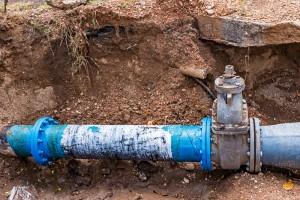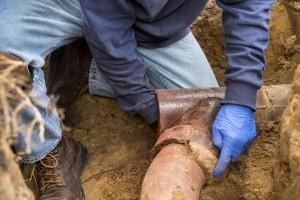
With summer being the rainy season in Florida, Orlando’s afternoon thunderstorms leave a lot of puddles behind. But when the sun reemerges and there’s one spot on your lawn that just doesn’t dry out, you hold your breath and hope for the best. But you can’t hold that breath for long – and when you take your next breath, your nostrils may detect a dreaded odor. It could be a sewer leak.
We here at Certified Leak Detection offer this guide to detecting a sewer leak before it becomes an even more serious issue.
How does the sewer line run under your home and what causes it to leak?

Each pipe in your home is connected to a large pipe called the lateral connection, which runs under your home at an angle into the municipal sewer system. It is not your responsibility that your city’s sewer system works well, but when it comes to your lateral connections, you need to make sure that they remain in good condition. Like any other plumbing pipe, these lateral connections can leak over time.
The wastewater lines from each toilet, sink and tub run under the slab to the pipes that run beneath your yard. These are the sewer lines/pipes that run through your lawn and moves your home’s waste to the main sewer. The sewer pipes that run under the lawn and slab are two separate systems that work collectively to remove solid waste and waste water from your home to the city’s main sewer unit.
These underground sewer pipes can decay over time due to aging and sometimes reasons like tree root intrusion, which can cause leaks or a burst pipe. Sewer line leaks and burst pipes can also result from long-term obstructions. Ground tremors due to major construction activity near your house can also result in sewer pipe line leaks or bursts.
Sewer leak signs and symptoms
In houses that have sewer lines ranging from 25 to 30 years old, you should be extra aware of the signs of leaks. The lifespan of a cast iron sewer pipe is anywhere from 25 years to 35 years depending on the household usage. Danger signs include the following:
Watch out for a slow drain – This can be an indication of a blockage somewhere in the sewer line which might cause sewage backup. In case the water starts draining slowly from your sink, toilet, and bathtub even after you get the line cleared is a sign that there may be a problem somewhere in the sewer line.
Smelling sewer gas odor in or around your house – This is a definite indication that there is a problem in the sewer line.
Frequent sewage backups and blockages – If the backup is isolated to one single toilet, sink or bathtub, it could be a localized problem. But, if most of the wastewater outlets don’t drain properly every time, then there could be an issue with your sewer lines. This is indicative of a sewer problem like tree root intrusion, a crack that brings in soil, a misaligned pipe connection or channeling.
Extra lush green patches in the lawn – If you notice lush green patches in your lawn, it could be due to sewage leak. Sewer water is, after all, basically fertilizer – which makes the grass greener in the area where there is a leak.
Mold growth – If you see mold behind your walls, call for repair immediately. Mold is a serious health hazard that needs to be eliminated by a mitigation company, separately from calling for repair to the sewer pipe. This can indicate is a crack or break in the sewer line near the wall. Mold combined with sewer gas odor is a likely sign of a sewer break.
A puddle of septic wastewater in your yard – If you notice a puddle anywhere in your yard, it can be a sign of a broken sewer line. A broken septic tank, cracked main line, or blocked drain fields could likely be the reason for a puddle in your yard.
A crack in the foundation slab, sinkholes or foundation settlement – These are extreme signs which means a sewer leak has been left unattended for long. In case there is a leak in the main line under your slab, a void is created under the foundation which results in foundation crack, foundation settlement and even sinkholes.
A hollow space in your lawn or under the pavers – A sewer leak left unattended for long can cause a hollow space in your lawn or under the pavers.
While an area of standing water may indicate another problem, our May 2018 blog post covered the causes and signs of leaks that occur under driveways and slabs. Whatever the cause, any leak on your property needs to be addressed as soon as possible, if only from the standpoint of water conservation. Our October 2017 blog post covered the importance of conserving water – from its significance as a valuable resource to saving money on utility bills.
Average cost of repairing a sewer leak

According to HomeAdvisor, repairing a cracked sewer pipe costs approximately $2, 516. And, depending on the kind of damage, homeowners can spend anywhere from $1,050 to $4, 001. Replacement costs may range from $315 to $1, 254. Keep in mind that these are only national averages, and are not intended to represent what your actual cost may be.
There are many products and tests kits that are available in the market for sewer leak detection. However, dealing with a sewer leak is not a DIY project.
If you suspect trouble, Certified Leak Detection is experienced in Orlando leak detection and repair. Trusted by homeowners throughout Central Florida, our team is ready to answer your call. Contact us for quick, reliable service.

